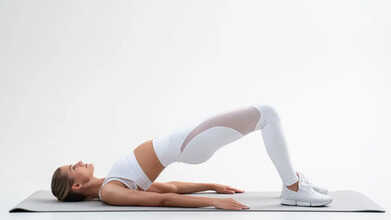- Health Conditions A-Z
- Health & Wellness
- Nutrition
- Fitness
- Health News
- Ayurveda
- Videos
- Medicine A-Z
- Parenting
- Web Stories
How To Do The Duck Walk To Build Strength And Lose Fat In Your Lower Body

Image Credit: Canva
For both fat loss and toning of the muscles, the duck walk is an underappreciated but very effective lower-body exercise. This energetic movement exercises your quadriceps, hamstrings, glutes, and calves as well as enhances mobility and flexibility. Although it may look easy, the duck walk involves several muscle groups and, when performed properly, can burn calories, increase strength, and improve lower-body endurance.
Adding the duck walk to your exercise routine can have dramatic results, but it must be done with proper form and gradual build-up to prevent injury. Let's dissect all you need to know about this intense movement, from its advantages to performance and mistakes to watch out for.
What is the Duck Walk?
The duck walk is really a walking squat that requires a deep range of motion and stability. Squatting down low and stepping forward in a controlled fashion, the exercise hits the lower-body muscles hard while at the same time engaging the core for stability. Because it replicates the natural squatting motion, the duck walk tightens the hip flexors, making it a good exercise for individuals with weak hips or lower-body imbalances.
Apart from building strength, the duck walk improves flexibility and mobility, especially in the hips, knees, and ankles. Those athletes coming back from an injury or those wishing to enhance agility can benefit specifically from this exercise.
How to Properly Perform the Duck Walk
Before incorporating the duck walk into your workout routine, it’s essential to understand the proper form and technique. Since this exercise places significant pressure on the knees, maintaining proper alignment is crucial.
Step-by-Step Guide to Duck Walk:
Step 1- Begin with your feet shoulder-width apart and squat down as low as possible while keeping your back straight and core engaged.
Step 2- Your front foot must stay flat on the ground, with the rear foot on its toes.
Step 3- Keep pushing back your glutes and distribute your weight evenly to prevent knee strain.
Step 4- Make small, controlled steps forward by transferring weight onto your leading foot, then moving the trailing foot forward while still keeping your squat position.
Step 5- Stepping forward for 10 steps, stand up, walk back to the beginning, and repeat for three repetitions.
Because the duck walk is an advanced move that needs strength and mobility, beginners need to approach it gradually.
Modifications Beginners Can Make to The Duck Walk
If you have flexibility issues or feel pain while doing the duck walk, use these modifications:
Half-Squat Duck Walk: Rather than descending into a full squat, walk forward in a half-squat posture.
Weighted Support: Supporting yourself with a dumbbell or kettlebell held in front of your abdomen aids in stability and balance.
Common Mistakes to Avoid During Duck Walking
Rising Too High: Standing up from the squat posture decreases the effectiveness of the exercise and puts extra stress on the knees.
Taking Big Steps: Big steps will throw your balance off and create instability, and the movement will become less controlled and more susceptible to injury.
Knees Buckling Inward: Misalignment can strain joints and decrease the efficiency of the movement.
Disregarding Core Engagement: Maintaining your core engaged is critical for good posture and stability.
Which Muscles are Targeted by the Duck Walk?
The duck walk is a multi-joint movement which involves several groups of muscles being used at one time:
Main Muscles: Quadriceps, hamstrings, glutes, calf muscles, and core muscles.
Secondary Muscles: Stabilizers and hip adductors.
Making it a very good addition to lower-body exercise routines, building and toning the legs along with enhancing the overall endurance level.
How to Add Duck Walk into Your Exercise Routine?
Because the duck walk is a challenging exercise, it must be placed strategically in your workout routine to prevent overexertion.
- Frequency: Do the duck walk twice a week for best results.
- Timing: Do not do this exercise during your warm-up period; instead, incorporate it during cardio or leg day for best effect.
- Combining with Other Exercises: Include it towards the end of a squatting session or place it within a circuit routine for endurance exercises.
For those aiming to lose fat, one effective way is to include the duck walk as part of a high-intensity interval training (HIIT) session. It is done in bursts with limited recovery time that can increase the heart rate and support fat reduction.
Who Shouldn't Do the Duck Walk?
Although the duck walk is a good exercise, it might not be for everyone. Those who suffer from arthritis, knee injuries, or have painful joints should not try it since it puts quite a strain on the knees. If you do feel pain or discomfort while exercising, go and see a fitness instructor or a physiotherapist for an assessment.
For those wishing to test the strength of their lower body and take their level of fitness to new heights, the duck walk is a perfect inclusion in any training regimen. Go slow, practice good form, and step up intensity as needed to strengthen the muscles, increase flexibility, and reach your goal of losing fat.
5 Pelvic Floor Exercises That Can Transform Your Sexual Wellness

Credits: Canva
Your pelvic floor muscles do much more for your sexual health than most people realise. These deep muscles support the bladder, uterus, and bowel, but they also play a big part in pleasure, performance, and confidence during intimacy.
Whether you’re healing after childbirth, managing incontinence, or simply aiming to feel more connected with your body, training your pelvic floor is a natural way to improve sexual wellness.
What Is Pelvic Floor Exercise?
Pelvic floor exercises, often called Kegels, focus on strengthening the group of muscles that create a supportive sling for the bladder, bowel, and, in women, the uterus. They are done by contracting these muscles, as if stopping the passage of urine or gas, holding the squeeze, and then releasing. Regular practice can improve bladder and bowel control, enhance sexual health, and aid recovery following childbirth in women or prostate surgery in men.ALSO READ: Is It Safe To Have Sex With Heart Disease? Expert Tells 5 Things You Should Keep In Mind
Benefits of Pelvic Floor Exercise For Better Sexual Health
Pelvic floor exercises can make a real difference in your sexual life. As per Mayo Clinic, by strengthening the muscles that support the bladder, uterus, and bowel, these exercises improve blood flow and muscle control in the pelvic area. This not only enhances arousal and sensitivity but can also lead to stronger orgasms and better stamina during intimacy. For many people, a stronger pelvic floor helps reduce discomfort, boost confidence, and create a greater sense of connection with their body and partner.ALSO READ: Can A UTI Cause You Your Limbs? Explains Doctor
5 Pelvic Floor Exercises to Boost Sexual Health
1. Kegel Exercises
How to do it:- Squeeze the muscles you use to stop urinating.
- Hold for 5 seconds, then relax for 5 seconds.
- Repeat 10–15 times, two to three times daily.
2. Bridge Pose
How to do it:- Lie on your back with your knees bent and feet flat.
- Lift your hips upward while tightening your glutes and pelvic muscles.
- Hold briefly, then lower down.
3. Deep SquatsHow to do it:
- Stand with your feet hip-width apart.
- Lower into a deep squat, keeping your chest lifted.
- Engage your pelvic muscles as you come back up.
4. Bird-Dog
How to do it:- Begin on your hands and knees.
- Extend your right arm and left leg at the same time.
- Hold, then switch sides.
5. Pelvic Tilts
How to do it:- Lie on your back with your knees bent.
- Flatten your lower back into the floor by tilting your pelvis upward.
- Hold for a few seconds, then relax.
Love Playing Football? Studies Show That Footballers Face A Higher Dementia Risk

Credits: Canva
Football, the world’s most popular sport, may come with an invisible cost: brain health. While players are celebrated for their stamina, skill, and longevity on the pitch, research shows that elite footballers are more likely to develop dementia and related neurodegenerative diseases later in life compared with the general population.
The main factor? Heading the ball.
The Swedish Study: What It Found
A major cohort study, published in The Lancet Public Health in 2023, followed 6,007 male footballers who had played in Sweden’s top division between 1924 and 2019. Their health outcomes were compared with 56,168 men from the general population.
- 8.9% of footballers were diagnosed with a neurodegenerative disease versus 6.2% of controls.
- Footballers had a 1.46 times higher risk of developing these conditions.
- Alzheimer’s disease and other dementias were significantly higher among players, with a 62% increased risk.
- No increased risk was found for motor neuron disease.
Surprisingly, footballers had a lower risk of Parkinson’s disease.
But the most striking finding was the difference between player positions. Outfield players, who head the ball regularly, showed a 50% higher risk compared with the general population, while goalkeepers, who rarely head the ball, showed no significant increase in risk.
This position-based difference strongly suggests that repetitive head impacts, even those not causing concussions, play a central role in long-term brain health risks.
Confirming Earlier Evidence
These Swedish results echo a 2019 Scottish study published in The New England Journal of Medicine, which found that former professional footballers were 3.5 times more likely to die of neurodegenerative disease compared with controls. That study also highlighted that defenders, who head the ball most often, were at the greatest risk.
Together, these studies strengthen the link between heading the ball and higher dementia risk, adding to growing international concern about football’s long-term safety.
Also Read: 21-year-old Billy Vigar Of Chichester City Dies Of Sustaining Brain Injury
Why Football Differs From Other Sports
Sports like boxing, rugby, American football, and ice hockey are already well-known for head injury risks. However, football is unique because concussions are relatively rare (<0.1 events per 1,000 player-hours), yet players repeatedly use their heads to control and redirect the ball.
This creates frequent “sub-concussive impacts”, blows to the brain too mild to cause immediate symptoms but capable of triggering long-term neurodegenerative changes. Chronic traumatic encephalopathy (CTE), a condition linked to repeated head trauma, has already been identified in athletes from other collision sports. Football’s heading tradition may be creating similar risks.
Changing the Game: Calls for Action
- Recognizing these risks, football associations have started to act.
- In the UK, heading is restricted in children’s training sessions.
- UEFA has issued guidelines limiting headers in youth football.
- In England, rules now cap the number of high-force headers in training for adult professionals.
Experts, however, stress that these measures may not be enough. Tara Spires-Jones, professor of neurodegeneration at the University of Edinburgh, noted that the stark difference between outfield players and goalkeepers reinforces the link between head impacts and dementia. She emphasized that while sports and physical activity overall reduce dementia risk, avoiding repetitive head injury is crucial for brain protection.
Has Modern Football Changed the Risk?
One question remains: do today’s footballers face the same level of risk as those who played in the mid-20th century?
The Swedish study noted that most players diagnosed with neurodegenerative disease had careers before the 1970s. Since then, major changes have reshaped the sport:
- Leather balls, which absorbed water and became heavier, have been replaced by lighter synthetic ones.
- Training methods, tactics, and playstyles have evolved, potentially reducing—or even increasing—head trauma exposure.
- The modern game involves far more matches and intense training, meaning players may head the ball more frequently over a lifetime.
- Researchers caution that the long-term risks for today’s players remain uncertain, and ongoing monitoring is essential.
Should People Suffering From Migraines Exercise? Neurologist Answers

(Credit-Canva)
For people who suffer from migraines, even normal activities like concentrating on work, holding a conversation can be difficult. These are things we do not think twice about, however, simply going through these can be a major task for people who suffer with migraines.
So, what about exercising? It is an activity that requires a lot of movements, some of which require you to do movements that jerk your body like jumping jacks. Is it safe for people with migraines to work out? According to Dr Sudhir Kumar, a Hyderabad-based neurologist, the answer is yes.
Getting regular physical activity is hugely helpful for people who get migraines because it can often make your headaches happen less often and feel less painful when they do occur. While a super-hard, intense workout might seem like it would only make your head hurt more, exercising smart and making it a habit can be a very effective way to prevent future migraine attacks. However, there are some things you need to keep in mind before doing so.
How to Exercise Smartly to Prevent Migraines
To get the most benefit from working out and avoid accidentally causing a migraine, people need to be mindful of five simple rules:
Be Consistent, Not Extreme
It's the steady routine that pays off. Doing regular exercise at a medium effort level (moderate intensity) helps keep migraines away. On the flip side, sudden, super-tough, or "all-or-nothing" workouts—like running a marathon with no training—can shock your system and easily trigger an attack. The goal is to build a steady habit, like a morning walk or a bike ride a few times a week, rather than pushing yourself to exhaustion once a month.
Figure Out Your Personal Triggers
Everyone is different, and certain activities might be a trigger just for you. For instance, some people find that lifting very heavy weights causes a headache, while others get one from running outdoors on a very sunny day or simply forgetting to properly warm up their muscles. The best way to understand these unique headache causes is to keep a diary of your headaches and write down what you did right before the migraine started.
Watch the Clock (Timing Matters)
Doing a very intense workout right before bed, late in the evening, can make it hard for you to fall asleep or get good rest. Poor sleep is a well-known migraine trigger, so late-night intensity can create a double problem. To protect your sleep, it's generally best for migraine sufferers to plan their workouts for the morning or during the day.
Pick the Right Environment
Your surroundings can put stress on your senses. To avoid this sensory strain, choose a workout spot that is comfortable. Cool, well-aired rooms with soft lighting are much better than places that are hot, stuffy, or have bright, intense lights that can make your head ache worse.
Try Adding Mind-Body Activities
You can actually increase the headache-fighting power of your physical activity by adding calming practices. Things like yoga, deep breathing exercises, and mindfulness meditation are great because they help you manage stress and relax tight muscles in your neck and shoulders, both of which are common contributors to migraine pain.
Do Aerobic Exercises Help Migraines?
Dr. Sudhir explains that scientific research has repeatedly shown that regular aerobic exercise—that's any activity that gets your heart pumping, like brisk walking, cycling, or swimming—is highly effective. The recommendation is to aim for a moderate effort level, for about 30 to 40 minutes, three times a week. In fact, some studies suggest that doing this type of exercise consistently can reduce the frequency and severity of migraines just as well as certain preventive medications. The very best approach combines this steady cardio with gentle strengthening and stretching exercises for your neck and shoulders.
© 2024 Bennett, Coleman & Company Limited

